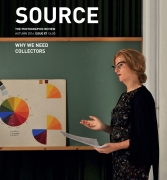EDITORIAL:
Issue 87 — Autumn 2016
Issue 87 — Autumn 2016
View Contents ▸
Museums and archives holding photography collections that aim to encompass the history of photography, like the National Media Museum, have been in particular difficulties recently. Meanwhile, those that focus on photography as an art form, like the Tate, have been doing comparatively well. In particular, they have had more success in attracting private backers: patrons willing to give them either money or photographs to enhance their collections. So what are they doing right? Can any museum attract wealthy donors or only those that show art? Will these backers only deal with institutions in London or elsewhere in the UK and Ireland? What do the super-rich expect in return for their gifts? To find out we spoke to an art advisor, a curator and a collector and they explain how contemporary museum patronage works.
The photographer and antiques expert John Rogers works under the company name Durbin Lewis. He sees his photographic constructions as a form of fictional antique shop that provides encounters between objects that are not as we would find them in the usual selling space. Some items are from his personal collection or for his personal use, others are stock that he buys and sells, or street finds. In this portfolio of images we find a mash-up of tattered mattresses, damask, rubber and nineteenth century mahogany furniture that challenges traditional systems of value and whose hashtag titles play with the way virtual content is organised and collated online.
Stuart Whipps has produced a new piece of work from a collection of photographs found in a disused photography lab in Johannesburg that he discovered while on a residency there. Whipps is interested in developing and exploring alternative narrative forms to supplement the often 'dumb nature of photographs'. In this case he uses the addition of texts from a flash fiction creative-writing workshop, whose members were invited to write about the images after Whipps reinstated the collection back in South Africa as a form of 'research lab'. Trish Morrissey's new work Ten People in a Suitcase was produced on a residency in Mänttä, Finland in response to an archive of over 30,000 photographs, often of anonymous subjects, that record the life of the town. Through performance the work explores how historic photographs function in the world.
The next issue of Source will be a special 'Photobooks' themed issue. It will also contain new columns and a new reviewer of self-published books. Both Daniel Jewesbury and Judith Williamson will continue to be asked to write for Source but as they give up their regular-columnists slots we would like to thank them for their many and valued contributions over recent years.
— The Editors





